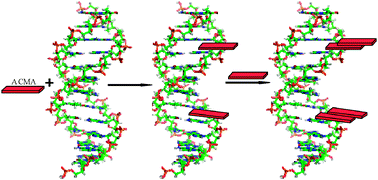ACMA (9-amino-6-chloro-2-methoxy acridine) forms three complexes in the presence of DNA†
Abstract
The interaction of

* Corresponding authors
a
Universidad de Burgos, Departamento de Química, 09001 Burgos, Spain
E-mail:
nataliabyv@msn.com, begar@ubu.es, jmleal@ubu.es
Fax: +34 947258800
b
Universidade Nova de Lisboa, Faculdade de Ciências Médicas, CIGMH, Departamento de Genética, 1349-008 Lisboa, Portugal
E-mail:
jgaspar.gene@fcm.unl.pt, cmartins.gene@fcm.unl.pt
c
Università di Pisa, Dipartimento di Chimica e Chimica Industriale, 56126 Pisa, Italy
E-mail:
alessiab@ns.dcci.unipi.it, ferdi@dcci.unipi.it
The interaction of

 Please wait while we load your content...
Something went wrong. Try again?
Please wait while we load your content...
Something went wrong. Try again?
N. Busto, B. García, J. M. Leal, J. F. Gaspar, C. Martins, A. Boggioni and F. Secco, Phys. Chem. Chem. Phys., 2011, 13, 19534 DOI: 10.1039/C1CP22158B
To request permission to reproduce material from this article, please go to the Copyright Clearance Center request page.
If you are an author contributing to an RSC publication, you do not need to request permission provided correct acknowledgement is given.
If you are the author of this article, you do not need to request permission to reproduce figures and diagrams provided correct acknowledgement is given. If you want to reproduce the whole article in a third-party publication (excluding your thesis/dissertation for which permission is not required) please go to the Copyright Clearance Center request page.
Read more about how to correctly acknowledge RSC content.
 Fetching data from CrossRef.
Fetching data from CrossRef.
This may take some time to load.
Loading related content
